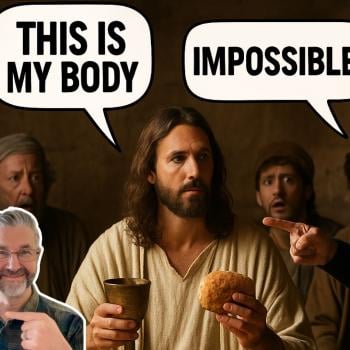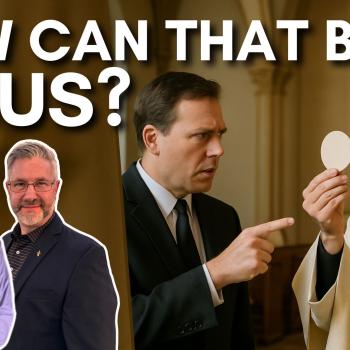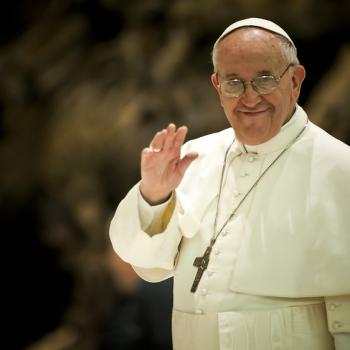. . . Now and Always (Including Liturgical Discussion)
THE GOOD OL’ DAYS “Traditionalists” maintain that a Catholic born, say, in 1943, knows all about how wonderful the Church used to be, whereas now it is merely a shell of its former glory. Such a person should be quite grateful that they weren’t born in 343 or 943, or 1043 or 1343 or 1743 — bleak periods all (and not the only ones). I contend that many “traditionalists” suffer from historical tunnel vision.
(From my book, Pensées on Catholic Traditionalism, #136)
Times of great revival and reform can occur even while heterodox liberals and heretics remain a problem. They are merely pawns in God’s Grand Scheme, just as the Egyptians or Assyrians or Babylonians or Romans were. They are already irrelevant, and destined for obsolescence in the dustbin of history, like all other heresies and schismatic sects (where are, for example, the Marcionites or Albigensians these days?).
(from my book, Protestantism: Critical Reflections of an Ecumenical Catholic)
What happened in those other years?
Arian crisis (4th-6th centuries), moral decadence, the Great Schism (3 “popes” claiming to be pope at one time), the so-called “Enlightenment.”
The devil is always trying to subvert the Church with false ideas and heresy. This is true at all times in Church history. Those who think doom and gloom now don’t seem to have an inkling of what has gone on in the past. The history of the Church itself is the best argument for the indefectibility of the Church, based on God’s promises.
Modernism began to infiltrate the Church in the early 1800s, from liberal Protestantism. The “modern modernists” started having influence around 1940. My mentor, Fr. Hardon, used to say that is the date when the “revolution” (modern Catholic liberalism) began.
The liberals haven’t succeeded in changing a single doctrine of the Church. They are wildly successful in places like Anglicanism, though . . .
Obviously, if the Novus Ordo / Pauline Mass isn’t done according to how it is supposed to be done, then there is a legitimate criticism. But a corruption of a thing is not the thing itself.
Liturgical mediocrity is a human tendency across the board, and doesn’t tell against validity in the slightest. Given a choice between often irreverent Novus Ordo and almost always reverent Tridentine, those who are rightly looking for proper reverence will often choose the latter. I completely understand that.
I don’t have to make such a choice, myself, because my parish offers an extremely reverent Novus Ordo Mass (including in Latin). We also have the Tridentine occasionally in my parish and regularly in my parish cluster. I prefer the Novus Ordo. Catholics have that wonderful freedom to worship as they please. 22 Rites . . .
* * *
A lot of that [revision of the Missal] is translation issues, as I understand it, which again is not the thing itself, but how it is presented from one language to another.
Catechesis contnues to be atrocious in many quarters. This is one of my great motivators to do what I do: apologetics being the half-sister of catechesis. The catechist describes WHAT we believe, the apologist WHY we believe it. They go hand in hand.
But the modern lay apologetics movement that I am proud to be part of is a bright spot in modern Catholicism. There are many bright spots, if one will look more closely. Revival always starts slowly and picks up speed and grows, like a snowball rolling down a hill.
It seems that there is a presumption that a music director will choose wisely and not do stupid things. Obviously that is not the case too often, so then it becomes necessary to have a little more direction and more legalistic rubrics, because of stupidity on the part of some folks who are involved in a Mass. This is the human condition: give an inch and many will take a mile.
[Todd Aglialoro] There’s a great passage from Chesterton’s St. Thomas Aquinas: “The Dumb Ox”: from near the end of part 1:
It is not at all easy for us to feel that distant events were thus disconcerting and even disreputable. Revolutions turn into institutions; revolts that renew the youth of old societies in their turn grow old; and the past, which was full of new things, of splits and innovations and insurrections, seems to us a single texture of tradition.
I attend a church that was built in 1873: a German Gothic Revival building that I think is the prettiest in Detroit, with some of the best stained glass in North America, and the largest set of bells.
My remark at the top (from my book) was aimed at those who are in despair, and ready to abandon Holy Mother Church (and to deny the indefectibility of the Church) because there are serious problems. The point is that there are always serious problems. There were in the early Church (Galatians, Corinthians) and at every age. The only thing that changes is the particular set of problems that any given age is confronted or burdened with.
Those who have tunnel vision are the ones who think that, somehow, today’s situation is the worst ever. That is far from the case.
Judas was an enemy from within Jesus’ own circle: that’s a one out of 12 ratio. What else is new? Almost every historical heresy begins with a fallen-away Catholic.
My main point was to deny that the Church is “merely a shell of its former glory.” The Church is indefectible. It goes through cycles of corruption and decadence, followed by revival. Fr. Hardon always used to say that the worst centuries in the Church are followed by centuries of revival. It’s coming. It may take a few more years. I expect to be an old man before it becomes truly manifest and undeniable.
Here is an observation on the Church in the 16th century:
The eminent German Catholic theologian Karl Adam, in his book The Roots of the Reformation (translated by Cecily Hastings, New York: Sheed & Ward, 1951 [portion of One and Holy, 1948] ), states that “the Renaissance Popes seem to have carried out in their own lives that cult of idolatrous humanism, demonic ambition and unrestrained sensuality” (p. 14). He quotes the words of Pope Adrian VI (1522-23), who in turn cited St. Bernard: “Vice has grown so much a matter of course that those who are stained with it are no longer aware of the stink of sin” (p. 20).
The majority of this clerical proletariat had neither the intellectual nor the moral capacity to so much as guess the profundity of the questions raised by Luther . . . In this waste of clerical corruption it was impossible for the Spirit of our Lord to penetrate into the people . . . There was no sacramental impulse towards an interiorizing and deepening of religion. So the attention of the faithful was directed towards externals . . . This hideous simoniacal abuse of indulgences corrupted true piety . . . indulgences were perverted to a blasphemous haggling with God. Night fell on the German Church . . . (pp. 22-26)
Dave, but would you go as far as saying that both forms of the Roman rite are theologically speaking equal and that there is no superiority between one and the other?
The Tridentine Mass did not “always exist.” I showed in one of my papers that many elements of the Pauline Mass preceded the Tridentine by many centuries, and were even the norm in the early Church. See my paper, “Apologia For the Mass of Pope Paul VI, With Massive Historical Documentation From Catholic Tradition / Summary of Vatican II on Liturgical Reform”.
And the same Fr. Hardon said, as I also noted above, that the worst centuries are followed by centuries of revival; hence, no place for despair. This is what my initial comment above was addressing: pessimism, despair, loss of faith, lack of trust that God remains in control of Holy Mother Church, despite men’s sin and error; indefectibility.
None of what I say denies that there is a modernist crisis. Of course there is. I presuppose that. I am saying, “okay, now what? Do we give up, or do we trust that God will correct things in the long run, as He always has throughout Church history?” Fr. Hardon had that firm faith that things would get better. So do I. It takes time. Church history moves at a geological pace. But it does assuredly move, and revival follows corruption and decadence and massive loss of faith and truth.
Those of us who are rightly concerned with the state of Catholicism and Catholics, have the motivation to get up off our butts and start doing something, to help change things and make them better. Let’s take that energy and zeal and do something constructive, rather than descend into despair or schism (as in the case of the most extreme radtrads). The harvest is ready; the laborers are few. Every person can make some difference. The truth and the gospel and the fullness of the faith are contagious.
And one way we can change things in one generation is to have lots of kids and raise them right, to be good, solid Catholics, by teaching them correctly and being proper models of a lived-out, joyous Catholic faith. I have tried my best to live what I am “preaching”: four children (my wife Judy, sadly, has also had six miscarriages, but that is six more souls in heaven, I believe): all home-schooled, all solid Catholics with excellent morals. It’s all by God’s grace: all glory to Him. We simply have to be obedient and accept and apply that grace. But we have to cooperate and be obedient to Him: that’s the bottom line.
Truth is what it is, despite any scandals swirling around it. And it has the power to draw those who seek it.
Of course the laity should have a voice. Remember, Cardinal Newman is my hero. He is the one who was a big advocate of the laity playing a larger role. Vatican II and recent pronouncements of popes reassert the same thing. Lay apologetics is strongly supported. Do whatever you can to oppose heterodoxy. I think much of the problems we have today in the Church are because of liberal or lax bishops.
Just bought Pensées on Catholic Traditionalism. You give me so much hope; I was starting to think that everyone around me was losing faith in the Church, even apologists! Eager to buy more :) God bless you. You put into words what I want to say on your blog and back it up with copious facts, history, etc.!
I tend to use “radtrad” more today, to signify an extreme traditionalist, that is what i am opposing. Much of the concern of self-described “traditionalists” I agree with and observe myself (e.g., the very traditional liturgy at my church). I critique tendencies and attitudes, and never name a single name in my book on the topic. My concern is with excess and the schismatic spirit and lack of charity that can too often be observed.
Theological liberals hate nothing more than being ignored and regarded as inane and irrelevant. :-) They think they are in the “progressive” forefront, when in fact, they are in the caboose, and about to be disconnected from the train, to roll down the hill into oblivion . . .
Secularization is a huge threat. If we refuse to be salt and light and decide to blend into the world then our souls are in peril, and the Church ceases to be to the culture what it should be, because we her members are so compromised.
A group of Catholics in Pittsburgh, who don’t accept the teachings of the Church, rallied over the weekend, calling for women Priests and marriage for Priests. Some of the women there are self proclaimed Priests. How sad.
For the life of me, I don’t know why people like that don’t simply become Anglicans. They have to play games.
***
Stay in touch! Like Biblical Evidence for Catholicism on Facebook:













